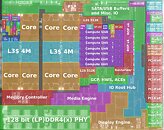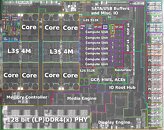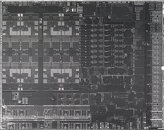- Joined
- Oct 9, 2007
- Messages
- 47,233 (7.55/day)
- Location
- Hyderabad, India
| System Name | RBMK-1000 |
|---|---|
| Processor | AMD Ryzen 7 5700G |
| Motherboard | ASUS ROG Strix B450-E Gaming |
| Cooling | DeepCool Gammax L240 V2 |
| Memory | 2x 8GB G.Skill Sniper X |
| Video Card(s) | Palit GeForce RTX 2080 SUPER GameRock |
| Storage | Western Digital Black NVMe 512GB |
| Display(s) | BenQ 1440p 60 Hz 27-inch |
| Case | Corsair Carbide 100R |
| Audio Device(s) | ASUS SupremeFX S1220A |
| Power Supply | Cooler Master MWE Gold 650W |
| Mouse | ASUS ROG Strix Impact |
| Keyboard | Gamdias Hermes E2 |
| Software | Windows 11 Pro |
VLSI engineer Fritzchens Fritz, famous for high-detail EM photography of silicon dies and annotations of them, recently published his work on AMD's 7 nm "Renoir" APU silicon. His die-shots were annotated by Nemez aka GPUsAreMagic. The floor-plan of the silicon shows that the CPU component finally dwarfs the iGPU component, thanks to double the CPU cores over the previous-gen "Picasso" silicon, spread over two CCXs (compute complexes). The CCX on "Renoir" is visibly smaller than the one on the "Zen 2" CCDs found in "Matisse" and "Rome" MCMs, as the L3 cache is smaller, at 4 MB compared to 16 MB. Being MCMs with disintegrated memory controllers, it makes more sense for CCDs to have more last-level cache per CCX.
We also see that the iGPU features no more than 8 "Vega" NGCUs, so there's no scope for "Renoir" based desktop APUs to feature >512 stream processors. AMD attempted to compensate for the NGCU deficit by dialing up engine clocks of the iGPU by over 40% compared to those on "Picasso." What caught our eye in the annotation is the PCI-Express physical layer. Apparently the die indeed has 20 PCI-Express lanes besides an additional 4 lanes that can be configured as two SATA 6 Gbps ports thanks to SerDes flexibility.



This would mean that "Renoir" can finally spare 16 lanes toward PEG (PCI-Express graphics, or the main x16 slot on your motherboard), besides 4 lanes toward the chipset-bus, and the final four lanes allocated to the M.2 NVMe slot that's wired to the AM4 socket, on a typical desktop platform. On the mobile platforms, "Renoir" processors spare no more than 8 lanes toward PEG (discrete graphics), including when paired with discrete GPUs such as the GeForce RTX 2060 (mobile), which is capable of gen 3.0 x16. Previous generation desktop APUs such as "Picasso" and "Raven Ridge" spare no more than 8 PCIe gen 3.0 lanes toward PEG, even on the desktop platform. x16 PEG capability would bolster the credentials of desktop "Renoir" processors for premium gaming PC builds, using some of the top SKUs such as the Ryzen 7 4700G.
View at TechPowerUp Main Site
We also see that the iGPU features no more than 8 "Vega" NGCUs, so there's no scope for "Renoir" based desktop APUs to feature >512 stream processors. AMD attempted to compensate for the NGCU deficit by dialing up engine clocks of the iGPU by over 40% compared to those on "Picasso." What caught our eye in the annotation is the PCI-Express physical layer. Apparently the die indeed has 20 PCI-Express lanes besides an additional 4 lanes that can be configured as two SATA 6 Gbps ports thanks to SerDes flexibility.



This would mean that "Renoir" can finally spare 16 lanes toward PEG (PCI-Express graphics, or the main x16 slot on your motherboard), besides 4 lanes toward the chipset-bus, and the final four lanes allocated to the M.2 NVMe slot that's wired to the AM4 socket, on a typical desktop platform. On the mobile platforms, "Renoir" processors spare no more than 8 lanes toward PEG (discrete graphics), including when paired with discrete GPUs such as the GeForce RTX 2060 (mobile), which is capable of gen 3.0 x16. Previous generation desktop APUs such as "Picasso" and "Raven Ridge" spare no more than 8 PCIe gen 3.0 lanes toward PEG, even on the desktop platform. x16 PEG capability would bolster the credentials of desktop "Renoir" processors for premium gaming PC builds, using some of the top SKUs such as the Ryzen 7 4700G.
View at TechPowerUp Main Site







